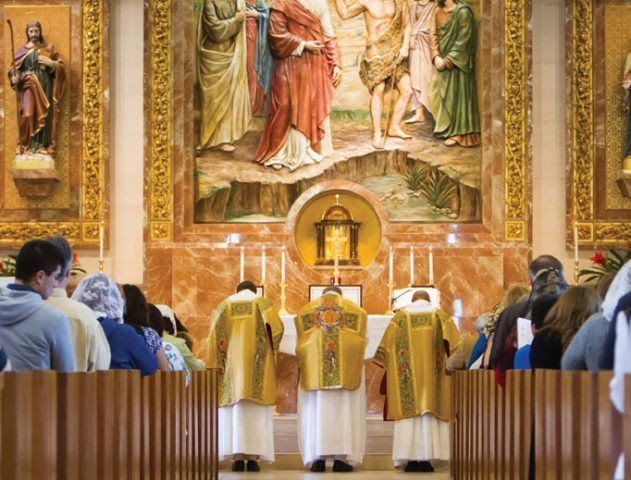Full pews. Active community outreach. Spiritual growth.
Is this what constitutes a thriving parish?
Just as every parish is a distinct community with a distinct “personality,” each may have its own blueprint for success.
“For a parish to genuinely thrive in the sense of what the Church means by fruitfulness or effectiveness, it has to embrace the mission of the Church: to evangelize,” explained Dave Nodar, founder and director of ChristLife, a ministry that helps parishes develop a process to make missionary disciples. Nodar pointed out that evangelization is “introducing people to a personal encounter with the living Lord Jesus.”
“It’s the magisterium calling us to know we can have this relationship with God.”
Sequoia Sierra is a relatively new parishioner at St. John the Baptist in Costa Mesa, California, but she has been attending Mass and receiving the sacraments at the parish for many years.
Home to the Norbertine priests of St. Michael’s Abbey in Silverado Canyon, California, the parish offers confession five days of the week and opportunities for a weekly hour of adoration (in addition to the monthly “Day of Adoration”).
“I think the availability of the sacraments … lends itself to having a more devout congregation, and that in turn inspires the faithful to participate and be more involved in their faith, and therefore at the parish,” said Sierra, a designer and entrepreneur in her late 20s.
St. Agnes Church in Naples, Florida, is a parish filled with a mix of seniors and young families, according to 10-year parishioner Patrick Novecosky, 48.
It’s an interesting dichotomy, but together the two groups make up one very active community — in no small part because the parish seeks out parishioners and invites them to put their talents to work. “Rather than just whoever has the time to volunteer, there’s a real discernment: Who has what gifts, and where do those gifts fit in the parish?” said Novecosky, the president of NovaMedia, a Catholic marketing and communications company.
He and his wife, Michele, had just welcomed their third child when they registered at the parish in 2007; now they are parents of five. Michele has served as a volunteer with the first reconciliation and first Communion program, and Patrick was one of the founding members of the parish pastoral council, and he serves as a lector.
“Parishes exist to build community, and they exist to catechize and evangelize,” he said. “If those things are going on … and there is a plan for building community and for catechesis … you can’t help but have a thriving, dynamic parish.”
At St. Ambrose Cathedral in Des Moines, Iowa, the rector, Father John Bertogli, estimates that about three-fifths of the 775 parishioners are refugees, primarily from South Sudan, Burma and Eritrea; the rest are a mix of Asian, Hispanic and Anglo families.
It’s a parish that underscores what Father Bertogli already believed: “From my experience in being a pastor at small county-seat parishes, city parishes, rural parishes, or big metro city parishes, what makes a parish thrive and grow is its spirit of hospitality.”
“Once people see a faith community based in outreach, hospitality and welcome, that’s when people tend to get excited and interested — because they feel they have a place where they belong.”
St. Ambrose parishioners from disparate cultural and socioeconomic backgrounds band together in ministry, from serving at Mass to volunteering as catechists in the religious-education program.
The St. Ambrose Knights of Columbus — many of whom are refugees — jump in whenever needed, including the Lenten Friday fish lunches, which draw parishioners and community members, including people who work in downtown buildings and construction sites.
“A parish is to be inclusive, welcoming all and missionary, reaching out to all,” said Des Moines Bishop Richard Pates. “A parish thrives when it engages all members in its mission of witnessing to love of God.”
Raised in a musical family, Allen Stetson played in St. Clare of Assisi parish’s band for 13 years, alongside his wife for several of them, until they had children.
“Our duty to care for our babies took us off the band riser, and we looked for other ways to contribute,” said Stetson. A lead pipeline developer for Weta Digital, it was easy for him to come up with a new way to serve his Canyon Country, California, parish.
He engaged his wife, Ji Sun, a graphic designer, to design an attractive layout for the parish website. “I then researched wiki back ends and secure infrastructure, leveraging my knowledge of PHP, Python and other technology. I mocked up a version of the website on a staging server and called the parish office to set up a meeting with my pastor. I prepared a slideshow for him and pitched the website redesign.”
For many years now, the Stetsons have managed the parish website — a job they can easily squeeze into schedules busy with three young sons and full-time jobs. They love to put their gifts to work for the parish — and at St. Clare, which involves parishioners in every facet of parish life, they are not alone in that.
At the heart of St. Helen’s in Westfield, New Jersey, is a love of service, too. Half a century old, the parish is the spiritual home for 4,000 households.
“The outreach of this community is incredible,” said the pastor, Father Michael Saporito.
St. Helen’s runs a weeklong summer camp for children with cancer. It sends its high-school students to “Catholic Heart Work Camp” every year. Every big celebration — Thanksgiving, Christmas and Easter — is an opportunity for parishioners to collect food and other donations to distribute to families in need in the surrounding communities.
“Every parish does something with some kind of exceptional piece to it,” said Father Saporito. “You want to start building it from there.
“If we grow our people in the Gospel, our communities will thrive.”
Elisabeth Deffner writes from Orange, California.







